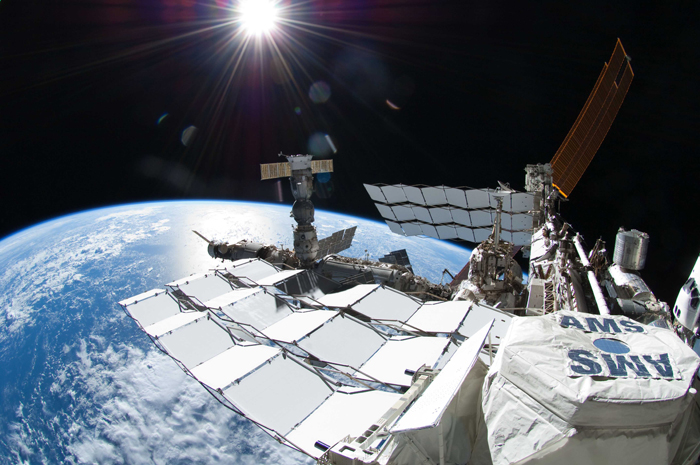.

Measuring excess: the AMS-02 experiment
.
Invoking dark matter as a means to explain the excess of positrons observed last year by the Alpha Magnetic Spectrometer (AMS-02) experiment might not be necessary, according to physicists in Europe. Instead, they say, the entire dataset can be explained purely in terms of known astrophysical processes such as pulsars and cosmic rays.
Dark explanations?
Last April, the AMS-02 experiment, which is mounted upon the International Space Station, reported a spike in the fraction of positrons – the antimatter counterpart of electrons – coming from beyond the solar system. Conventional wisdom says that the dominant process for creating positrons in the Milky Way is high-energy protons scattering off the galactic disc. Such a scenario would see the number of positrons drop off at higher energies. However, the AMS-02 result seemed to show a rise in the number of positrons as the energy increased above 10 GeV. This backed up a similar high-energy positron excess uncovered by the PAMELA and Fermi satellites in 2008 and 2011, respectively.
Some saw the confirmed excess as possible proof for the existence of dark matter through the annihilation of "weakly interacting massive particles" or WIMPs – the leading candidate for dark matter – that would produce a swathe of positrons in that energy range. Others have cast doubt on whether the perceived excess exists at all. Now, a new model created by a team led by Mattia Di Mauro at the University of Turin, Italy, can recreate the AMS-02 data, including the spike, without resorting to dark matter, although that does not necessarily rule it out as an option. "It is still possible to vary the astrophysical parameters to include a dark-matter contribution and be compatible with observations," Di Mauro told physicsworld.com. However, when it comes to explaining the unexpected peak, the team points the finger at pulsars instead.
Cascading positrons
A pulsar is a rapidly rotating neutron star with an intense magnetic field. Such a magnetic field can in turn generate an electric field that is capable of ripping charged particles from the surface of the neutron star. The charged particles are then accelerated, producing a cascade of particle/antiparticle pairs, including electrons and positrons. This forms part of an out-flowing "pulsar wind", which injects the particles into the interstellar medium. Di Mauro and colleagues were able to model the electron/positron flux emitted by local pulsars in the Australia Telescope National Facility (ATNF) Pulsar Catalogue.
They then examined the way these particles propagate throughout the galaxy, losing energy through interactions with the Milky Way's radiation field. That allowed them to calculate the number and energy of positrons arriving at Earth. "The high-energy part of the AMS-02 positron flux finds a remarkable solution in terms of pulsars present in the ATNF catalogue," says Di Mauro. The team also recreated the low-energy region of the AMS-02 data by modelling the flux of additional positrons created by additional sources such as supernova remnants, and those created by cosmic rays interacting with interstellar material.
Not everyone is convinced, however. "I believe the positron excess is most naturally explained by a nearby supernova remnant shock wave," says Subir Sarkar, who divides his time between the University of Oxford and the University of Copenhagen. Along with Philipp Mertsch, of Stanford University, US, Sarkar first proposed in 2009 that the shock wave accelerates cosmic rays, causing them to bounce back and forth across the wavefront. Some of the positrons are also accelerated, boosting their energy and explaining the excess.
Mertsch and Sarkar have recently updated their proposal, and crucially, it makes a prediction that can distinguish between the two explanations. At higher energies, they expect future AMS-02 data to show a rise in both the proton/antiproton ratio and the boron/carbon ratio. The final answer might come with the release of the next AMS-02 dataset.
The research is published in the Journal of Cosmology and Astroparticle Physics.
Quelle: physicsworld
5449 Views
